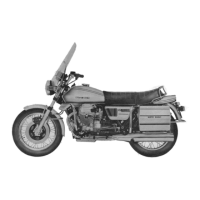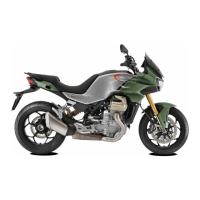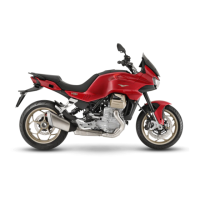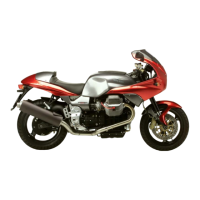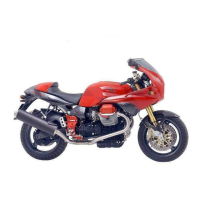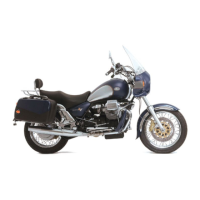Do you have a question about the MOTO GUZZI V1000 G5 and is the answer not in the manual?
Detailed specifications for the motorcycle's engine, including cylinder disposition, bore, stroke, displacement, and compression ratio.
Description of the valve train mechanism, specifying it as O.H.V. with push rod operation.
Details on the carburettors fitted, including make, type, and model numbers for both right and left sides.
Information on the lubrication system, detailing the type of pump and filters used, and normal operating pressure.
Specifies the location and output rating of the generator-alternator unit.
Outlines ignition system details, including advance timing, contact breaker gap, and spark plug types.
Describes the electric starter system, its power rating, control method, and button location.
Details the clutch type, control mechanism, and its operation.
Specifies the primary drive mechanism and its ratio.
Describes the gearbox, including speed count, engagement type, and pedal operation.
Explains the secondary drive system, including the cardan shaft and bevel gear set ratio.
Specifies the type of rims and their size for both front and rear wheels.
Lists the tire specifications for both front and rear wheels, including size and type.
Details the twin disc brake system for the front wheel, including control methods and caliper specifications.
Describes the rear disc brake system, its controls, and caliper specifications, noting interconnection with the front brake.
Provides key dimensions such as wheelbase, length, width, height, and minimum ground clearance, along with total weight.
Lists the motorcycle's top speed and estimated fuel consumption.
Emphasizes the use of original Moto Guzzi spare parts to maintain warranty validity.
Outlines the warranty period, limitations, conditions, and the importance of the coupon-book.
Explains the three positions of the ignition key and their functions.
Details the four positions of the light switch located on the handlebar.
Describes the function of switch 'B' in relation to low and high beam settings.
Identifies the buttons for horn, flashing lights, and turn signals on the left handlebar.
Locates the engine start and emergency stop button on the right handlebar.
Explains the function and location of the easy start lever for cold engines.
Describes the throttle control grip operation for acceleration and deceleration.
Details the clutch lever's use for engine starting and gear shifting.
Explains the operation of the right front brake lever connected to the master cylinder.
Describes the combined control pedal for front left and rear brakes.
Explains the gear shift pedal operation for changing gears.
Details how to access the fuel filler cap using the ignition key.
Explains the fuel level warning light and its connection to the tank.
Describes the three positions of the fuel taps located at the rear of the tank.
Identifies the location of the electrovalve and its activation condition.
Specifies the location and number of fuses in the terminal block.
Lists electrical functions controlled by the ignition key.
Lists electrical functions that operate independently of the ignition key.
Provides instructions on how to lock and unlock the motorcycle's steering.
Explains the use of the side stand and recommends the center stand for longer stops.
Lists essential checks before starting the engine, including ignition, fuel, oil, and warning lights.
Step-by-step guide for starting the engine from cold, including throttle and clutch operation.
Instructions for starting the engine when it is already warm.
Guidance on changing gears, using brakes, and handling the motorcycle while riding.
Procedures for safely stopping the motorcycle and shutting off the engine.
Instructions for parking the motorcycle, including using parking lights and locking the steering.
Provides recommended maximum speeds for different mileage intervals during the running-in period.
Details how to adjust the free play of the clutch control lever.
Explains the procedure for adjusting the play in the front brake control lever.
Specifies the procedure and limits for checking brake pad wear.
Outlines the requirements for checking the condition and cleanliness of braking discs.
Guides on checking and topping up brake fluid and the schedule for replacement.
Describes the process of removing air from the hydraulic braking systems.
Step-by-step instructions for bleeding the right front brake circuit.
Instructions for bleeding the front left and rear brake circuits.
Refers to the warning light indicating the need to check fluid levels.
Instructions related to bleeding the brake system using the control pedal.
Details how to check and adjust the clearance of the front left and rear brake pedal.
Explains how to adjust the rear suspension spring positions.
Provides instructions for adjusting the steering to eliminate play while ensuring free movement.
Step-by-step guide for removing the front wheel, including brake caliper and spindle procedures.
Instructions for removing the rear wheel, covering drive box, spindle, and brake components.
Describes how to check and adjust wheel spokes for tightness and trueness.
Discusses the importance of tire condition, tread depth, and pressure for stability and safety.
Provides guidance on the correct mounting direction for tires with directional arrows.
Outlines monthly checks, including electrolyte level in the battery.
Specifies periodic checks, such as tire pressure.
Details checks to be performed every 500 km, including crankcase oil level.
Lists initial maintenance tasks, including oil renewal and checking bolt tightness.
Maintenance tasks required every 10,000 km, such as cleaning fuel system components.
Maintenance tasks required every 15,000 km, including brake fluid replacement.
Specifies major maintenance tasks to be performed by a dealer after 20,000 km.
Details how to check and maintain engine oil levels and perform oil changes.
Explains how to check and replace the gearbox oil at specified intervals.
Guides on checking and changing the oil in the rear drive box.
Instructions for replacing the oil in the front fork legs.
Recommends dealer service for lubricating steering and rear fork bearings.
Identifies the type and model of carburettors used on the motorcycle.
Step-by-step guide for adjusting carburation and idling speed manually.
Recommends dealer service for carburation adjustment using a vacuometer.
Specifies the replacement interval for the air filter cartridge and its location.
Outlines the procedure for cleaning fuel system components.
Explains how to check and adjust tappet (valve) clearance for optimal engine performance.
Details the maintenance and adjustment procedures for the double contact breaker points.
Explains how to inspect and adjust the fixed ignition timing using the flywheel.
Guides on setting the ignition timing for the left cylinder.
Information on spark plug types, gap settings, cleaning, and replacement intervals.
Details the battery specifications, access, and procedures for installing a new battery.
Provides guidelines for regular battery maintenance and troubleshooting.
Instructions for replacing various light bulbs, including the headlight.
Explains how to adjust the headlight's horizontal and vertical aim.
| Bore x Stroke | 88 mm x 78 mm |
|---|---|
| Fuel System | Dell'Orto carburetors |
| Ignition | Electronic |
| Transmission | 5-speed |
| Final Drive | Shaft |
| Front Suspension | Telescopic forks |
| Rear Suspension | Swingarm with twin shock absorbers |
| Front Brakes | Dual disc |
| Rear Brakes | Single disc |
| Displacement | 948 cc |
| Torque | 75 Nm @ 5, 000 rpm |
| Frame | Steel |
| Fuel Capacity | 24 liters |
| Engine Type | 90° V-twin, 2 valves per cylinder |
